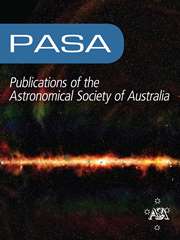Article contents
Radial and Latitudinal Gradients in Galactic Cosmic Rays
Published online by Cambridge University Press: 25 April 2016
Abstract
We have deduced the yearly averaged value of the solar diurnal variation as observed by a surface muon telescope and three underground muon telescopes over the years 1957 to 1985. This has allowed us to examine the temporal variation in both the latitudinal gradient Gz and the product of the parallel mean free path and the radial gradient  of galactic cosmic rays during three consecutive solar cycles. The median rigidities of the primary particles being detected by the telescopes are 50 GV in the case of the surface muon telescope and greater than 150 GV in the case of the underground muon telescopes. We have compared our results with those of a similar study made from observations of the solar diurnal variation by neutron monitors and an ion chamber, which have median rigidities of response between 17 and 70 GV (Bieber and Chen 1991a). The product
of galactic cosmic rays during three consecutive solar cycles. The median rigidities of the primary particles being detected by the telescopes are 50 GV in the case of the surface muon telescope and greater than 150 GV in the case of the underground muon telescopes. We have compared our results with those of a similar study made from observations of the solar diurnal variation by neutron monitors and an ion chamber, which have median rigidities of response between 17 and 70 GV (Bieber and Chen 1991a). The product 

- Type
- High Energy Astrophysics
- Information
- Publications of the Astronomical Society of Australia , Volume 11 , Issue 2 , August 1994 , pp. 170 - 174
- Copyright
- Copyright © Astronomical Society of Australia 1994
References
- 3
- Cited by


